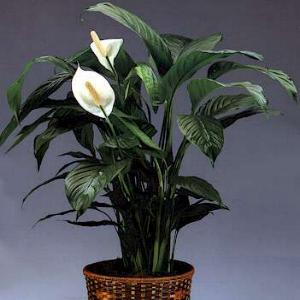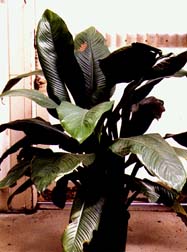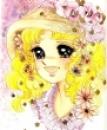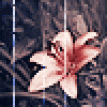RoĹľi od Lumidee in Candy nista enaki. Candy je napisala ime svoje roĹľe. Mislim, da ima Lumidee tole:
Spathiphyllum
 Description - Origin
Description - Origin
Once more its greek name describes it in detail. Leaves (and flowers) that look like swords (spathi: sword).Â
Impressive foliage, relief to the touch, at the end of a thin long branch. Its white flowers, as impressive, come as the perfect distraction to the dark green foliage. Both characteristics made spaths very popular to those who love green/foliage plants as well as to those who prefer flowering plants.Â
Even though spaths originated in South and Central America (mainly Colombia and Venezuela) they are today the most popular indoor plant in the U.S. and U.K. In fact, they are one of the favorite subjects of growers all over the world, so we get new varieties almost every day, the new plants having more impressive foliage, richer blooming and which are in general hardier than the plants available today.Â
Care
It is one of those great plants who adapt easily to different conditions and that s mainly the reason they are so widely used in homes, offices, restaurants and malls.Â
Spaths grow not higher but wider as they age. New leaves appear among and around the base of old leaves, coming straight out of the soil. This is also the criterion to consider when buying a new plant, as this is a sign of a healthy plant that will develop well.Â
If you buy spaths for their flowers, choose a plant that has at least one flower in full bloom so that you know exactly what you are buying. As we mentioned before, there are numerous varieties that differ in both the size and the color-tone of the flowers. Spaths, like most tropicals, need excellent drainage so the soil should contain peat moss and sand and pebbles should be placed at the bottom of the pot.
Spaths, like most tropicals, need excellent drainage so the soil should contain peat moss and sand and pebbles should be placed at the bottom of the pot.
You should water approximately once a week from fall till spring and 2-3 times a week during the summer months. Before you water, check the surface of the soil which should be dry to the touch. If the soil is still wet do not water because spaths are very prone to root rot.Â
It needs plenty of humidity in its environment but is soil should not be wet for too long and do not let the pot sit in water. To provide additional humidity place the pot on a pebble tray but make sure it does not stand in water. If the roots stay wet for even a short period, the tips of the leaves will go yellow. If however the plant stays wet for more than 5-6 weeks its roots will rot and the plant will die. Also, if you notice yellow leaves in the center of the plant, you probably overwater so cut down on the frequency. If on the other hand, the outside leaves turn yellow, your plant is probably getting too much light.Â
Â
































  rože od lumidee nisem videla. to je res spatifil. zelo preprosta roža za negovanje, sama pove, kdaj je žejna (listi se povesijo in ko jo zaliješ je v eni uri spet lepa), če jo malo gnojiš, ti cveti lahko tudi celo leto. jaz imam dve in ena ima tako rekoč neprekinjeno po šest ali osem cvetov, stara je pa že več kot 10 let. ne sme biti na direktnem soncu, rabi pa veliko svetlobe. od sredine maja pa do 1. novembra jo dam v senco na vrt. lp.
 rože od lumidee nisem videla. to je res spatifil. zelo preprosta roža za negovanje, sama pove, kdaj je žejna (listi se povesijo in ko jo zaliješ je v eni uri spet lepa), če jo malo gnojiš, ti cveti lahko tudi celo leto. jaz imam dve in ena ima tako rekoč neprekinjeno po šest ali osem cvetov, stara je pa že več kot 10 let. ne sme biti na direktnem soncu, rabi pa veliko svetlobe. od sredine maja pa do 1. novembra jo dam v senco na vrt. lp.

  a pomeni, da je preveč toplo...ker jo imam tle v sobi in je res bolj toplo..oki sem jo umaknila daleč stran od radiatorja...pa se še vedno rumenijo. Kako pogosto pa zalivaš ti? A ti je že veliko zrasla????
 a pomeni, da je preveč toplo...ker jo imam tle v sobi in je res bolj toplo..oki sem jo umaknila daleč stran od radiatorja...pa se še vedno rumenijo. Kako pogosto pa zalivaš ti? A ti je že veliko zrasla????




 Â ...
 ... 
